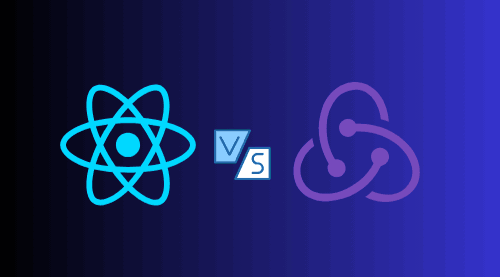Introduction
In the world of modern web development, React and Redux are two powerful tools that developers frequently use to build dynamic and efficient web applications. But while both are essential in their own right, they serve very different purposes. Understanding the distinctions between Redux and React can help developers decide when to use each technology to its full potential.
What is React?
React is a JavaScript library developed by Facebook for building user interfaces, particularly for single-page applications. It allows developers to create large web applications that can update and render efficiently in response to data changes. React’s main goal is to be fast, scalable, and simple.
Key Features of React
Component-based Architecture
React uses a component-based architecture, which means the UI is divided into small, reusable pieces called components. Each component has its own logic and controls its own rendering, making the development process more modular and manageable.
Virtual DOM
The Virtual DOM is a lightweight copy of the actual DOM that React uses to optimize updates and rendering. When the state of an object changes, React updates the Virtual DOM first, compares it with the previous state, and then only changes the elements in the real DOM that actually need to be updated.
JSX Syntax
JSX is a syntax extension for JavaScript that allows developers to write HTML directly within React code. This makes the code more readable and easier to write by combining the power of JavaScript with the flexibility of HTML.
Benefits of Using React
Reusability of Components
Components in React can be reused throughout the application, reducing redundancy and improving code maintainability. This reusability also speeds up the development process.
Improved Performance
With its Virtual DOM, React ensures that updates are handled efficiently, leading to faster rendering times and a more responsive user interface.
Strong Community Support
React has a vast community of developers and a rich ecosystem of libraries and tools. This support makes it easier to find solutions to problems, share knowledge, and integrate third-party functionalities.
What is Redux?
Redux is a predictable state container for JavaScript applications. It helps manage the state of an application in a centralized and predictable way. Redux can be used with any JavaScript framework or library, but it is most commonly associated with React.
Key Features of Redux
Centralized State Management
Redux stores the entire state of an application in a single object tree called the store. This centralized state management makes it easier to track changes and debug applications.
Predictable State Updates
State updates in Redux are handled by pure functions called reducers. These reducers take the current state and an action as inputs and return a new state. This predictability ensures that the application state is consistent and reliable.
Middleware Support
Redux allows developers to use middleware to handle asynchronous actions, logging, crash reporting, and more. This extensibility makes it a flexible solution for complex applications.
Benefits of Using Redux
Simplified State Management
By centralizing the state, Redux simplifies the process of managing and updating the application state, especially in larger applications with complex state interactions.
Ease of Debugging
Redux’s predictable state updates and centralized store make debugging easier. Developers can track every action and state change, making it simpler to identify and fix issues.
Consistency Across the App
With Redux, the application state is consistent and synchronized across different components, leading to a more stable and predictable user experience.
React vs Redux: Core Differences
Purpose and Use Case
React is primarily focused on building user interfaces and managing component states. In contrast, Redux is designed to manage the global state of an application. While React handles the view layer, Redux takes care of the state layer, making them complementary tools.
State Management Approach
React uses a component-level state management approach, where each component can have its own state. Redux, on the other hand, uses a single global state for the entire application, ensuring that the state is consistent and accessible from any part of the app.
When to Use React
Best Scenarios for Using React
React is best suited for applications that require dynamic and interactive user interfaces. It excels in projects where performance and reusability are critical, such as social media platforms, e-commerce websites, and dashboards.
Examples of Projects Suitable for React
- Social networking sites
- E-commerce platforms
- Data visualization dashboards
When to Use Redux
Best Scenarios for Using Redux
Redux is ideal for applications with complex state management needs, where multiple components need to share and update the state consistently. It is especially useful in larger applications with numerous interacting states.
Examples of Projects Suitable for Redux
- Enterprise-level applications
- Applications with extensive forms and input management
- Apps requiring offline capabilities
How React and Redux Work Together
Integration of Redux with React
Combining React with Redux allows developers to build powerful and maintainable applications. React components handle the UI, while Redux manages the state. By using the connect function from react-redux, components can access the Redux store and dispatch actions to update the state.
Benefits of Combining Both
The combination of React and Redux provides a robust solution for building scalable applications. React’s component-based architecture and efficient rendering work seamlessly with Redux’s predictable state management, resulting in a more organized and performant application.
Common Misconceptions
React vs Redux Misconceptions
One common misconception is that React and Redux are competing technologies. In reality, they complement each other. Another misconception is that Redux is only necessary for large applications. While it shines in complex projects, it can also simplify state management in smaller applications.
Clarifying Misunderstandings
Understanding that React handles the view layer and Redux manages the state layer helps clarify their roles. Also, recognizing that Redux can be gradually introduced into a React application can ease the adoption process.
Performance Considerations
Performance Impact of Using React
React’s Virtual DOM significantly enhances performance by reducing the number of direct DOM manipulations. This makes React suitable for applications that require high performance and responsiveness.
Performance Impact of Using Redux
Redux can introduce some overhead due to the need for state management and middleware. However, the benefits of predictable state updates and centralized state management often outweigh the performance costs, especially in larger applications.
Learning Curve
Learning React
React has a relatively gentle learning curve, especially for developers familiar with JavaScript. The component-based architecture and use of JSX are intuitive, and there are extensive resources and tutorials available.
Learning Redux
Redux has a steeper learning curve compared to React. Understanding concepts like reducers, actions, and middleware can be challenging initially. However, once mastered, Redux greatly simplifies state management.
How can TechDotBit help you about Redux and React?
TechDotBit is a comprehensive resource for anyone looking to master Redux and React. With expert-led courses, in-depth tutorials, community support, personalized mentorship, and career development services, TechDotBit provides everything you need to succeed. Whether you’re just starting or looking to deepen your expertise, TechDotBit is your go-to platform for mastering these essential web development technologies.
Reach out to us today in order to learn more about how we can help you about Redux and React for your organization.
Conclusion
In summary, both React and Redux are powerful tools that serve different but complementary purposes. React excels in building dynamic user interfaces with its component-based architecture and efficient rendering. Redux shines in managing the state of complex applications with its centralized and predictable state management. By understanding their differences and knowing when to use each, developers can harness the full potential of these technologies to create robust and maintainable web applications.
FAQs
- Can I use React without Redux?
- Yes, you can use React without Redux. React has its own state management system for managing local component states. Redux is only necessary for more complex state management needs.
- Is Redux only for large applications?
- While Redux is particularly beneficial for large applications, it can also be useful in smaller projects that require consistent state management and debugging.
- Do I need to learn Redux if I know React?
- It depends on your project’s needs. For simple applications, React’s built-in state management might be sufficient. However, for more complex state management, learning Redux can be very beneficial.
- What are the alternatives to Redux for state management in React?
- Some popular alternatives include Context API, MobX, and Recoil. Each has its own strengths and use cases.
- How difficult is it to integrate Redux into an existing React project?
- Integrating Redux into an existing React project can be straightforward, especially with the help of libraries like
react-redux. However, it does require understanding Redux concepts and refactoring your components to connect to the Redux store.
- Integrating Redux into an existing React project can be straightforward, especially with the help of libraries like









